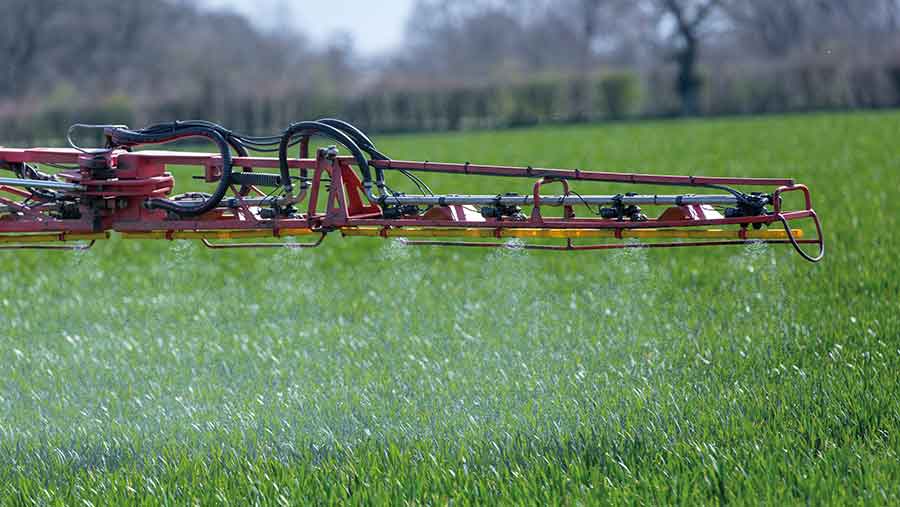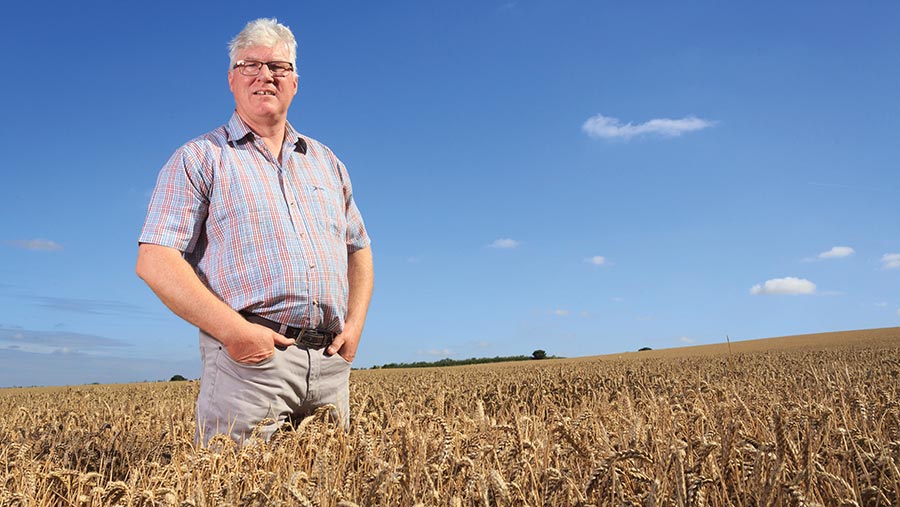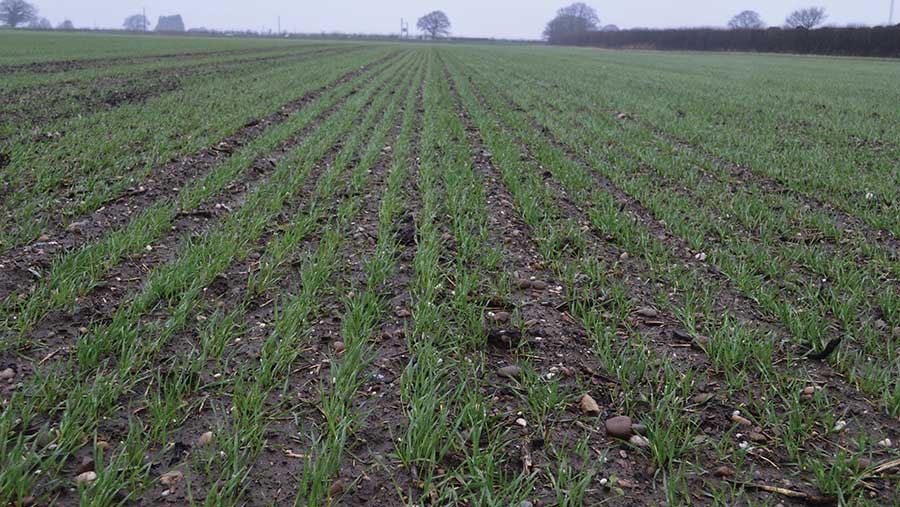Wheat yield prompts fungicide shift on Nottinghamshire farm
 © GNP
© GNP Richard Cross trialled a new SDHI fungicide on his winter wheat last year and gained an extra 0.4t/ha in yield over his farm standard, prompting him to make this latest SDHI his new standard for the future.
He used the new-for-this-season Iblon, to be marketed as Vimoy, in a wheat trial on the Nottinghamshire farm estate where he is manager. Richard saw a big step up in septoria control, as witnessed in tissue testing during the spring.
See also: SFI 2023: Tips on making it work on your arable farm
With this extra yield worth £64/ha, at a feed wheat price of £160/t, this season he plans to use the new SDHI, rather than his old farm-standard SDHI-azole mix Ascra, at the T1 spring timing on his well-established wheats.
Key wheat fungicides
- Ascra SDHIs bixafen and fluopyram plus azole prothioconazole
- Elatus Era SDHI benzovindiflupyr (Solatenol) plus prothioconazole
- Revystar SDHI fluxapyroxad (Xemium) plus azole mefentrifluconazole
- Univoq Picolinamide fenpicoxamid (Inatreq) plus prothioconazole
- Vimoy SDHI isoflucypram (Iblon), used in a twin pack with prothioconazole
“It’s worth spending a little more when you can see the reduction in disease pressure and the increase in yield,” he tells Farmers Weekly.
Vimoy will be widely available for the first time this spring in a twin pack with the azole prothioconazole as a broad-spectrum wheat fungicide to compete with similar SDHI-azole mixes such as Revystar, Elatus Era and Ascra, and also against the different mix in Univoq.

Richard Cross © Tim Scrivener
Fungicide trial
Richard conducted the fungicide trial last season on Oxton Estate in Nottinghamshire in conjunction with Vimoy manufacturer Bayer, ahead of the product’s full regulatory clearance and launch this spring.
The trial was conducted on the wheat variety Extase , grown as a second wheat on heavy land using 200kg/ha of nitrogen fertiliser. It specifically looked at disease control at the T1 fungicide spray timing, which usually occurs in late April.
The Vimoy-prothioconazole mix can only be used once in a season, and is likely to be used at T1 or T2.
T0 and T1
The whole field of Extase was treated at the early T0 stage in late March with a fungicide to protect against yellow rust. Then a 4ha block in the field was marked out for a different T1 treatment.
Before the T1 spray was applied, leaf four samples from the wheat crop were collected on 26 April and then tissue tested using Bayer’s CropCheck analysis for septoria and yellow rust.
Although little septoria was seen in the crop, the test gave a septoria score of 96. This was interpreted as showing a high septoria carryover in the crop and there was a need for curative and preventative treatment at the T1 stage.
By comparison, the score on the CropCheck analysis for yellow rust was just 1.
The T1 spray was then applied very soon after the tissue test, with the 4ha block treated at a rate of 1.2 litres/ha of Iblon and 0.6 litres/ha of prothioconazole.
The farm-standard SDHI-azole mix Ascra was applied across the rest of the field at 1.2 litres/ha, together with 1 litre/ha of the multisite protective fungicide folpet.

This late-drilled crop of Extase wheat has established well despite the very wet winter © David Jones
T2 spray
The whole field was then again tissue tested – using leaf threes – just before the T2 spray on 22 May, and the difference was stark, with the Iblon-prothioconazole area showing a septoria reading of 36, and the Ascra-treated area measuring 67.
“There was little visible difference between the two treated areas, so I was shocked at the big difference from the tissue testing, which showed septoria the eye could not see. We were seeing just over a 45% reduction in septoria between the two treatments,” says Richard.
With many fungicides now not giving the curative action seen in the past, this early warning tissue testing could be useful to devise fungicide strategies and get the right product on the crop at the right time.
The T2 flag-leaf fungicide choice was Univoq at 1.25 litres/ha soon after the 22 May tissue test. Richard says this is good product to use against septoria, as well as being good across the board on rusts.
Last season, Richard used Univoq at T2 across half of his 330ha of winter wheat, with the rest receiving Ascra. However, he will be looking to use Univoq across the board at T2 in the future.
Although some growers have seen sprayer damage after using Univoq, he experienced no problems after using the product in both his Chafer and Househam sprayers, as he kept spray water volumes high and the sprayers were properly cleaned out.
Univoq contains fenpicoxamid and prothioconazole, and as well as giving good septoria and rust control, as a non-SDHI mix it may help to delay the build-up of fungicide resistance.
T3 spray
A T3 head spray of 0.5 litres/ha of strobilurin azoxystrobin (Amistar) and 0.3 litres/ha of the azole tebuconazole was applied in June, largely to protect against late rust diseases.
So, although the two blocks looked very similar throughout the spring and early summer, the Iblon-prothioconazole T1-treated yield was 11.12t/ha and the non-Iblon 10.72/ha, to give the 0.4t/ha yield advantage.
“There must have been a reduction in latent septoria in the Iblon block. If you can not get control of septoria at T1, you are always chasing it, and it can hit yields and grain quality,” says Richard.
He grows 330ha of winter wheat within the 700ha of arable cropping on the 1,000ha estate, with 70% of the land heavy clay and the rest drought-prone sands and gravels.
On the heavy land, the rotation is two winter wheats, a malting winter barley and then oilseed rape, with varieties Gleam and Dawsum in the first wheat position, and Extase being tried as a second wheat for its good disease resistance.
On the lighter land, where yields are limited, Skyfall is grown for its milling premium, along with maize, and land is also contracted out for vegetable growing.
In the wet autumn and winter of 2023-24, the 85ha of Skyfall on the light land has generally established well, and he is considering using Iblon-prothioconazole at T1 and Univoq at T2 alongside appropriate T0s and T3s.
His heavy land winter wheats are more problematic this season after such wet weather and poor establishment, so his only commitment at the moment is to use a robust fungicide at T2.
The better disease control and yield increase with Iblon has come at a time when the whole estate is seeing yields grow after the introduction of a 4m strip-till Mzuri drill, with wheat yields rising 0.5t/ha over the last four years due to improvement in soil structure.
Wheat yields
Overall, average wheat yields reached 9.55t/ha last season, with a top yield of 11.44t/ha, when the farm previously struggled to get more than 9t/ha. Even the sand land wheats were achieving 8t/ha in 2023, when only 7.5t/ha was likely in the past.
AHDB fungicide performance trials have shown that Iblon provides good activity against septoria, especially as a protectant. It also gives good yellow rust control and is highly active against brown rust, the AHDB adds.
Using it in conjunction with prothioconazole is a good resistance management tactic and may improve overall control.

